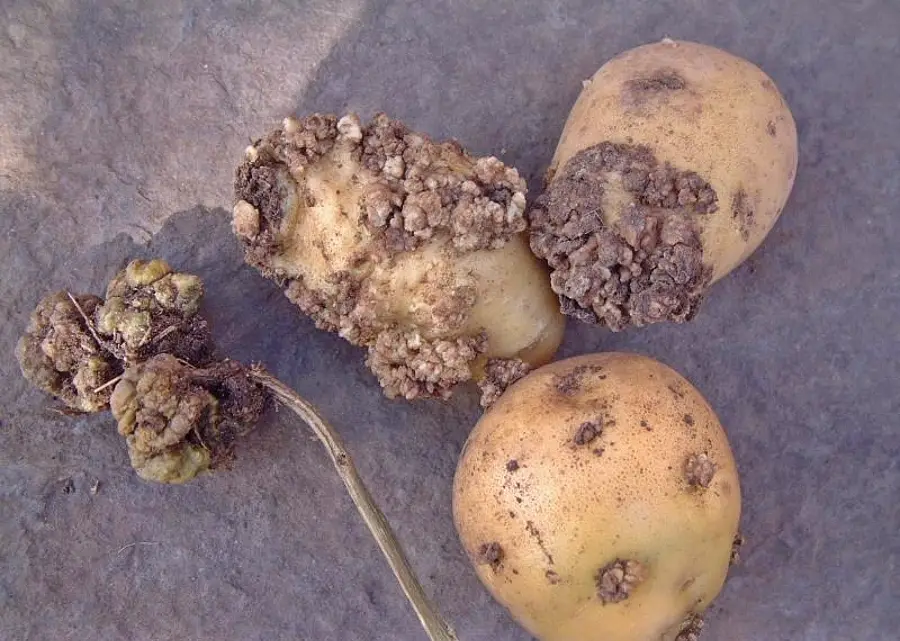Contents
SYNCHYTRIUM
CLASSIFICATION OF SYNCHYTRIUM
Division :- Eumycota
Sub-division :- Mastigomycotina
Class :- Chytridiomycetes
Order :- Chytridiales
Family :- Synchytriaceae
Genus :- Synchytrium

GENERAL CHARATERSTICS OF SYNCHYTRIUM
- The fungus generally occurs as an obligate parasite in the epidermal cells of various angiosperms.
- S. endobioticum attacks potato (Solanum tuberosum; vern alu; fam. Solauaceae) and causes serious disease called black wart disease or ‘potato-wart disease’, very common in Europe.
- In India, it is common in Darjeeling and West Bengal. Generally, the potato tubers are infected and show dark-brown, warty, cauliflower-like outgrowths. Galls may also be formed on aerial parts.
- S. trichosanthoides and S. lagenariae attack cucurbits and cause warts.
- S. rhytzii attacks Peristrophe bicalyculata, (Acanthaceae) and members of Labiatae.
- S. sesami attacks Sesamum indicum (vern, til; fam. Pedaliaceae).

STUDY OF THALLUS OF SYNCHYTRIUM
- The thallus is unicellular and non-filamentous.
- It is endobiotic (lying wholly within the host cell or cells) and holocarpic (whole of the vegetative thallus forms the reproductive unit).
- The globose, one-celled thallus may either be surrounded by a thick or a thin wall.
STUDY OF ASEXUAL REPRODUCTIVE STRUCTURES OF SYNCHYTRIUM
- Encysted zoospore infects the host by releasing the contents into the epidermal cell.
- The fungal thallus enlarges and stimulates the host epidermal cell to enlarge. 3. Adjacent host cells also enlarge to form a rosette of hypertrophied cells surrounding the infected epidermal host cell.
- The fungus after penetrating the host cell absorbs food material from surrounding protoplasm and grows in size. When it attains a certain size, a two layered wall is secreted, the outer being thick and golden yellow and the inner being thin and transparent. This is called as summer spore or prosorus.
- Inner wall alongwith protoplast protrudes out in the form of a sac in the upper portion of the host cell, through a pore formed in the outer wall of the summer spore. The nucleus of the summer spore now divides mitotically till there are 32 nuclei. This multinucleate protoplast is termed as summer sporangium.
- These form zoosporangia with many zoospores.
- Each zoospore is uninucleate and has a single posterior flagellum.
- The zoospore penetrates the fresh epidermal cells.

STUDY OF SEXUAL REPRODUCTIVE STRUCTURES OF SYNCHYTRIUM
- Sexual reproduction takes place by gametes formed during unfavourable conditions.
- The gametes are also formed in the same way as zoospores.
- Fusion of isogametes forms a zygote which after swimming in water for a while, penetrates the host cell.
- When zygote infects a host cell it undergoes hyperplasia (repeated cell division). As a result, zygote and its products get buried deep into the host tissue.
- The zygote rests inside the host cell, secretes a two layer wall–outer thick and inner thinaround itself and is known as resting spore or winter sporangium.
- On the return of spring, it divides meiotically into may uninucleate, haploid spores, which after liberation penetrate fresh epidermal host cells.
IDENTIFICATION
- KINGDOM – Mycota
- Chlorophyll absent
- Reserve food glycogen
- Cell wall of fungal cellulose.
- DIVISION – Eumycota
- A definite cell wall present.
- Sub-division :- Mastigomycotina
- Presence of motile spores or zoospores.
- Class :- Chytridiomycetes
- Usually unicellular
- Zoospores uniflagellate.
- Order – Chytridiales
- Asexual reproduction by posteriorly uniflagellate zoospores.
- Family – Synchytriaceae
- Thallus divided into a number of reproductive units and forms a sorus
- Genus – Synchytrium
- Galls are produced on host
- Resting spore is formed.

REFERENCES


Leave a Reply